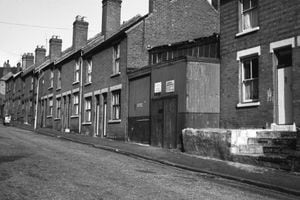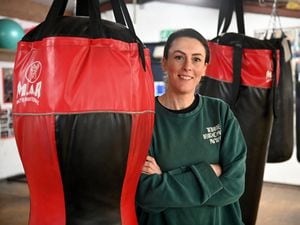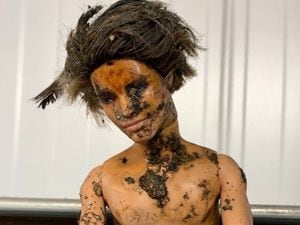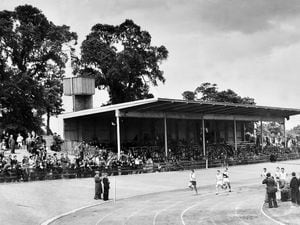Family wrote their name with pride across a city
For well over a century the meticulously hand-crafted masterpieces of the Harrington family were writ large across the Wolverhampton area.

Here and there in the city are a few surviving reminders of their signwriting skills.
And a collection of photos from Andy Harrington, the fourth – and last – generation in the business is evocative of a time before design computers, corporatism, and reduced demand brought the story of the family business to a close just over 20 years ago.
"Signwriting is a forgotten-about trade and it would be great to pay tribute not just to my family, but all the others that existed in the past," said Andy, who lives in Brewood.
"I know there used to be a gable wall at the junction of Stafford Street and the ring road where you used to be able to see the remains of one of my grandfather's masterpieces.
"Signwriting onto brickwork is a nightmare, but dad always said that his father was amazing at it and definitely the best out of all of us. Sadly most of it has been lost.
"We did a job for Goodyear Formula One racing division in which we had to hand-paint a design directly onto the face of some racing tyres, which I believe went all round the world."
It was Andy's great-grandfather, Charles Harrington, who started the company in Wolverhampton in 1872.
"In around 1898 he purchased a plot of land from a builder he knew and built his own workshop in Nursery Street, off Stafford Street, between two houses. It became known by the locals as 'The Shed'."
His son, also called Charles, but also known as Charlie or Chas, came into the business with a brother. Charlie in turn had sons, Charles – yes, yet another one – and Andy's father William, known as Bill.
"They lived in various homes until my granddad found the perfect spot around the corner from Nursery Street in North Street, an old pub called The Spring Cottage, converted into a home. They continued to work from The Shed along with a great uncle, Tom, and his two sons Syd and Alan, although they ran two separate companies.
"Eventually the whole area was redeveloped during the 1970s. My grandmother's house was flattened to make way for the extension to the Molineux, now where the Steve Bull stand is, and Nursery Street for the polytechnic expansion in 1979.
"My dad and uncle moved to a new industrial unit on Landport Road and the two cousins moved to Syd's home on Penn Road.
"I then joined the business as the fourth generation in 1983 and slowly learned the trade until I made the decision to finish it in 1999 after a couple of very bad years in which many of our customers had disappeared or moved away from using signwriting.
"I went on to do something completely different by working for National Express on the Midland Metro as a controller.
"Signwriting is a very ancient trade, using a rest stick with a fabric cloth rolled up into a ball on the end, a small tin of paint, using an old soup tin in our case, and a brush known as a writing pencil.
"These had to made from pure sable in order to create accurate letters. Without the use of computers, each design of writing and pictures or logos, was drawn out by hand and applied to all types of surfaces, from wood to glass to metal to brick.
"We worked for many famous Wolverhampton firms over the years, sadly many long gone. These included Guy Motors, Yale fork lift trucks, Tarmac, Goodyear tyres and several local building companies.
"There were also the likes of Mitchells & Butlers, Banks's, Ansells and a certain newspaper called the Express & Star. We have worked from scaffolding gilding clock faces, and if you go into St Peter's church in Wolverhampton you will find gilding done by my dad and me in the chancel.
"For a while Ansells set up a company called Holt's, Plant & Deakin, a series of traditional Black Country pubs, where a whole cottage industry of painters, carpenters, French polishers and signwriters worked to create authentic real ale pubs.
"The words 'health & safety' come to mind also. We were always responsible, but today's world would have looked on in horror at the way things were done.
"A story I was told was of how my family went to do some work at the old Snow Hill Station in Birmingham. Three of them held a tall ladder upright while the fourth person climbed up to attach a sign to some chains.
"Another incident was where my uncle Charles dropped a full tin of paint onto his cousin's head, who was standing underneath. It landed upside down. It was red and people passing by thought he was covered in blood."
The family wrote themselves into local history in several areas apart from signwriting.
"My grandfather, Charles Snr. was a founder member of the Wolverhampton Harriers, now Wolverhampton & Bilston AC and also helped to run boxing clubs. He was a real character, joke and storyteller who could find trouble wherever he went.
"In December 1963, he took a cruise by himself on board TSMS Lakonia, a Greek-owned ship, which caught fire and sank with the loss of 128 lives. Amazingly he survived after being pushed into the Atlantic by a member of staff and rescued by a fishing boat.
"It featured on the front page of the Express & Star at the time and the story was that he was concerned that he had lost his false teeth.
"My dad Bill became interested in jazz and after getting himself noticed by some big names in the business landed himself a job with the John Dankworth Orchestra and toured with him and his wife-to-be, Cleo Laine.
"He appeared on several Dankworth recordings, but also worked with a whole raft of names such as Ronnie Scott of Ronnie Scott's nightclub fame.
"He worked for the BBC and ATV studios in Birmingham, working on a live show with Jerry Allen and the actress Noele Gordon of Crossroads fame.
"After my grandfather returned from his ill-fated trip his health started to fail and at that point my father gave up touring and came back to the family business. My grandfather passed away in 1968.
"My dad's brother, Chas Jnr., got into weightlifting with his cousin Syd and opened gyms in the town, one of which was behind the Halfway House on Tettenhall Road. Charles became Midland champion and Syd, British and Commonwealth champion.
"Syd has his name on the Sporting Hall of Fame at Aldersley Stadium.
"It frustrates me to think that I never knew my granddad and all the amazing pieces of art that he created, many of which would have been seen at the time as normal, and destroyed when no longer needed."





